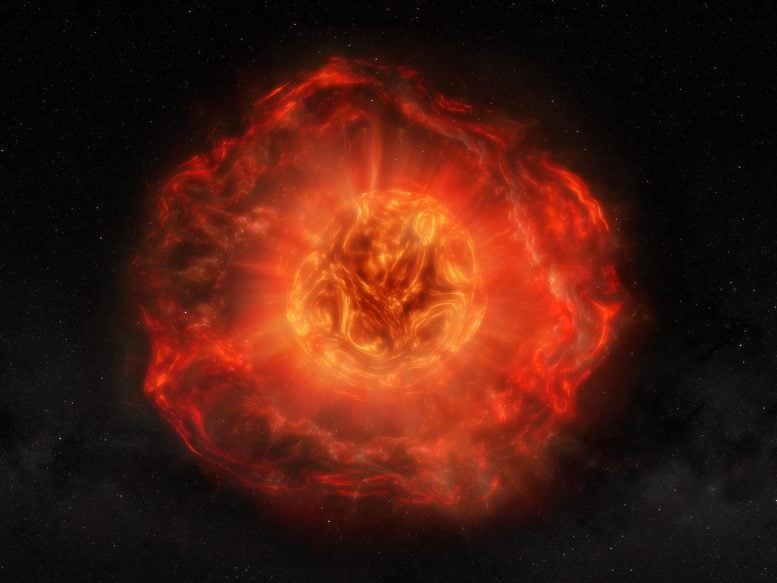
In the year prior to going supernova the red supergiant star now known as SN 2023ixf shed an unexpected amount of mass equivalent to the mass of the Sun. This artist’s conception illustrates what the final stages of mass loss might have looked like before the star exploded. Credit: Melissa Weiss/CfA
Evidence of extreme pre-explosion mass loss in a recently discovered supernova indicates there may be more going on in the last year of a star’s life than previously thought.
A newly discovered nearby supernova whose star ejected up to a full solar mass of material in the year prior to its explosion is challenging the standard theory of stellar evolution. The new observations are giving astronomers insight into what happens in the final year prior to a star’s death and explosion.
Core-Collapse Supernovae and SN 2023ixf
SN 2023ixf is a new Type II supernova discovered in May 2023 by amateur astronomer Kōichi Itagaki of Yamagata, Japan shortly after its progenitor, or origin star, exploded. Located about 20 million light-years away in the Pinwheel Galaxy, SN 2023ixf’s proximity to Earth, the supernova’s extreme brightness, and its young age make it a treasure trove of observable data for scientists studying the death of massive stars in supernova explosions.
Type II or core-collapse supernovae occur when red supergiant stars at least eight times, and up to about 25 times the mass of the Sun, collapse under their own weight and explode. While SN 2023ixf fit the Type II description, follow-up multi-wavelength observations led by astronomers at the Center for Astrophysics | Harvard & Smithsonian (CfA), and using a wide range of CfA’s telescopes, have revealed new and unexpected behavior.
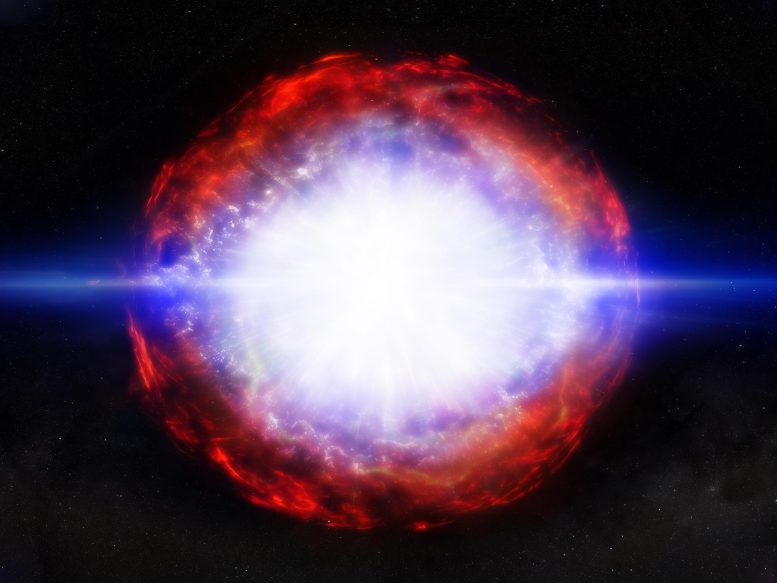
One of the nearest Type II supernovae in a decade and among the brightest to date, SN 2023ixf is a young supernova, discovered earlier this year by amateur astronomer Kōichi Itagaki of Yamagata, Japan. This artist’s conception shows the bright explosion of SN 2023ixf, which occurred after an unexpected amount of mass loss unlike anything astronomers have seen before. Credit: Melissa Weiss/CfA
Within hours of going supernova, core-collapse supernovae produce a flash of light that occurs when the shock wave from the explosion reaches the outer edge of the star. SN 2023ixf, however, produced a light curve that didn’t seem to fit this expected behavior. To better understand SN 2023ixf’s shock breakout, a team of scientists led by CfA postdoctoral fellow Daichi Hiramatsu analyzed data from the 1.5m Tillinghast Telescope, 1.2m telescope, and MMT at the Fred Lawrence Whipple Observatory, a CfA facility located in Arizona, as well as data from the Global Supernova Project— a key project of the Las Cumbres Observatory, NASA’s Neil Gehrels Swift Observatory, and many others. This multi-wavelength study, which was published this week in The Astrophysical Journal Letters, revealed that, in sharp contradiction to expectations and stellar evolution theory, SN 2023ixf’s shock breakout was delayed by several days.
Implications of the Delayed Shock Breakout
“The delayed shock breakout is direct evidence for the presence of dense material from recent mass loss,” said Hiramatsu, adding that such extreme mass loss is atypical of Type II supernovae. “Our new observations revealed a significant and unexpected amount of mass loss— close to the mass of the Sun— in the final year prior to explosion.”
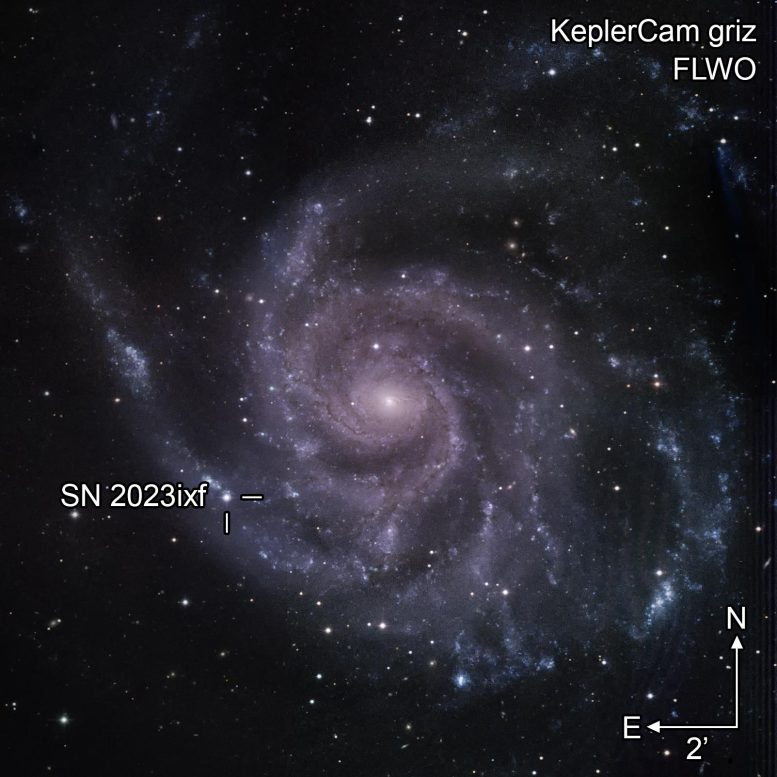
Captured using the 1.2m telescope at CfA’s Fred Lawrence Whipple Observatory on June 27, 2023, just over a month after SN 2023ixf’s progenitor star exploded, the image in this composite combines together green, red, near-infrared, and infrared light to highlight both SN 2023ixf and the Pinwheel Galaxy. SN 2023ixf is located in one of the spiral arms of the galaxy, as expected for the explosions of massive stars. Credit: S. Gomez/STScI
SN 2023ixf challenges astronomers’ understanding of the evolution of massive stars and the supernovae they become. Although scientists know that core-collapse supernovae are primary origin points for the cosmic formation and evolution of atoms, neutron stars, and black holes, very little is known about the years leading up to stellar explosions. The new observations point to potential instability in the final years of a star’s life, resulting in extreme mass loss. This could be related to the final stages of nuclear burn-off of high-mass elements, like silicon, in the star’s core.
Further Observations and Collaboration
In conjunction with multi-wavelength observations led by Hiramatsu, Edo Berger, professor of astronomy at Harvard and CfA, and Hiramatsu’s advisor, conducted millimeter-wave observations of the supernova using CfA’s Submillimeter Array (SMA) on the summit of Maunakea, Hawai’i. These data, which are published in The Astrophysical Journal Letters, directly tracked the collision between the supernova debris and the dense material lost before the explosion. “SN 2023ixf exploded exactly at the right time,” said Berger. “Only a few days earlier we commenced a new ambitious three-year program to study supernova explosions with the SMA, and this nearby exciting supernova was our first target.”
“The only way to understand how massive stars behave in the final years of their lives up to the point of explosion is to discover supernovae when they are very young, and preferably nearby, and then to study them across multiple wavelengths,” said Berger. “Using both optical and millimeter telescopes we effectively turned SN 2023ixf into a time machine to reconstruct what its progenitor star was doing up to the moment of its death.”
Significance of Amateur Astronomers
The supernova discovery itself, and the immediate follow-up, have significant meaning to astronomers around the world, including those doing science in their own backyards. Itagaki discovered the supernova on May 19, 2023, from his private observatory in Okayama, Japan. Combined data from Itagaki and other amateur astronomers determined the time of the explosion to an accuracy of within two hours, giving professional astronomers at CfA and other observatories a head start in their investigations. CfA astronomers have continued to collaborate with Itagaki on on-going optical observations.
“The partnership between amateur and professional astronomers has a long-standing tradition of success in the supernova field,” said Hiramatsu. “In the case of SN 2023ixf, I received an urgent email from Kōichi Itagaki as soon as he discovered SN 2023ixf. Without this relationship, and Itagaki’s work and dedication, we would have missed the opportunity to gain critical understanding of the evolution of massive stars and their supernova explosions.”
References:
“From Discovery to the First Month of the Type II Supernova 2023ixf: High and Variable Mass Loss in the Final Year before Explosion” by Daichi Hiramatsu, Daichi Tsuna, Edo Berger, Koichi Itagaki, Jared A. Goldberg, Sebastian Gomez, Kishalay De, Griffin Hosseinzadeh, K. Azalee Bostroem, Peter J. Brown, Iair Arcavi, Allyson Bieryla, Peter K. Blanchard, Gilbert A. Esquerdo, Joseph Farah, D. Andrew Howell, Tatsuya Matsumoto, Curtis McCully, Megan Newsome, Estefania Padilla Gonzalez, Craig Pellegrino, Jaehyon Rhee, Giacomo Terreran, József Vinkó and J. Craig Wheeler, 19 September 2023, The Astrophysical Journal Letters.
DOI: 10.3847/2041-8213/acf299
“Millimeter Observations of the Type II SN 2023ixf: Constraints on the Proximate Circumstellar Medium” by Edo Berger, Garrett K. Keating, Raffaella Margutti, Keiichi Maeda, Kate D. Alexander, Yvette Cendes, Tarraneh Eftekhari, Mark Gurwell, Daichi Hiramatsu, Anna Y. Q. Ho, Tanmoy Laskar, Ramprasad Rao and Peter K. G. Williams, 10 July 2023, The Astrophysical Journal Letters.
DOI: 10.3847/2041-8213/ace0c4


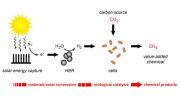
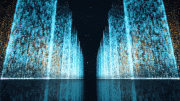
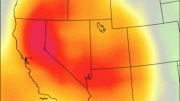

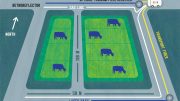


Be the first to comment on "Extreme Weight Loss: Shocking Supernova Discovery Challenges the Standard Theory of Stellar Evolution"